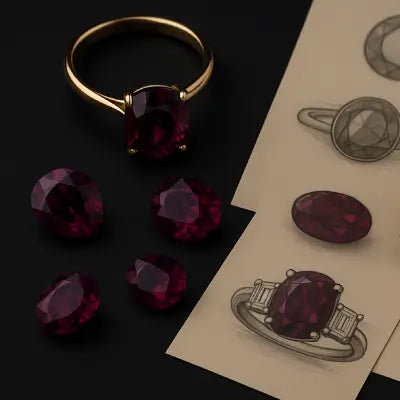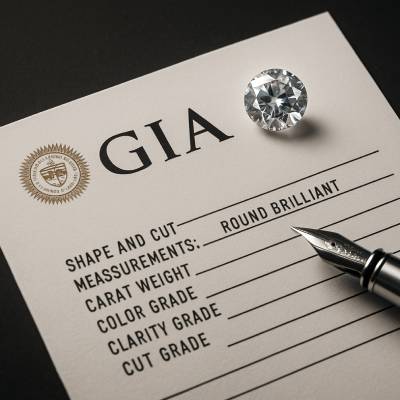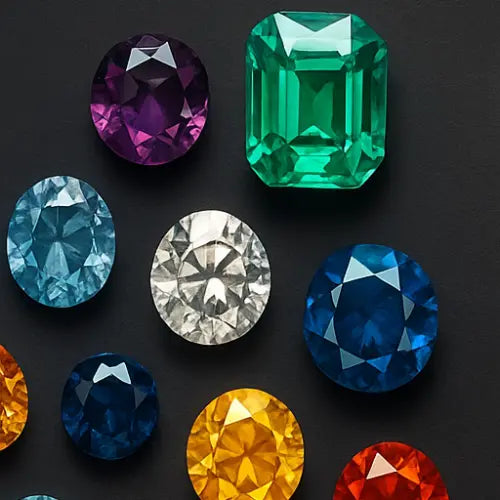Why do diamonds hold such a captivating place in our world?
These remarkable gems do more than just sparkle; they carry echoes of deep time, symbolize powerful emotions, and become treasured parts of our personal narratives. From their hidden creation within the Earth to their place in history and modern technology, understanding diamonds allows you to appreciate them fully and choose one that truly tells your story. As we explore this rare precious gemstone, let us guide you through your next diamond selection by exploring our thoughtfully curated collection of rings, necklaces, and earrings at Robin Woolard.
Navigating Value: Your Guide to the 4 Cs
Making an informed diamond choice starts with four key quality factors – universally known as the 4 Cs. Think of these as your compass points for navigating diamond quality:
- Cut - The Play of Light: Beyond the overall shape, the 'Cut' refers to how precisely a diamond's facets have been crafted. This artistry is crucial because it governs how the stone interacts with light. A well-executed cut unlocks a diamond's potential for brilliance (brightness), fire (rainbow flashes), and scintillation (sparkle), essentially dictating its visual energy.
- Clarity - Nature's Fingerprint: Diamonds are born deep within the Earth, and this process often leaves tiny internal characteristics or surface irregularities. These are not necessarily flaws but unique identifiers, a map of the gem's natural history. Clarity grading assesses these features under magnification, ranging from 'Flawless' (no visible characteristics) to 'Included' (characteristics noticeable to the eye).
- Carat - The Measure of Presence: Carat denotes the diamond's weight (one carat = 0.2 grams). While related to size, it's fundamentally about mass. Larger diamonds are exponentially rarer than smaller ones, making carat weight a significant driver of value. It influences the diamond's physical presence and rarity factor.
- Color - Towards Pure Transparency: For most diamonds, the ideal is a lack of color. The standard scale runs from 'D' (completely colorless) to 'Z' (light yellow or brown tint). Gemologists detect these slight differences under controlled conditions. The less color a diamond possesses, the rarer it generally is, enhancing its value (excluding fancy colored diamonds, prized for their hue's intensity).

Sculpted Expressions: Choosing a Shape
The diamond's outline, its 'shape, ' is a primary element of style, distinct from its technical cut quality. Each shape offers a different personality:
- Round Brilliant: The quintessential icon, engineered for maximum radiance.
- Princess: Delivers modern edge with its sharp, geometric form.
- Cushion: Merges soft corners with brilliant facets for vintage romance.
- Emerald: Offers understated glamour with its linear facets and clear view within.
- Pear: An elegant teardrop, unique and eye-catching.
- Oval: Provides a flattering, elongated take on classic brilliance.
- And More: From the symbolic Heart to the dramatic Marquise or intricate Asscher, diverse shapes cater to every taste.
A Journey Through Time and Meaning
The human connection to diamonds stretches back centuries. First unearthed in India, they journeyed across continents, eventually captivating European aristocracy. A pivotal moment arrived when a diamond sealed a royal betrothal, forever linking these gems with commitment. This rich history, combined with their unmatched hardness and brilliance, imbues diamonds with potent symbolism – endurance, purity, and everlasting love.
From Earth's Crucible: The Diamond's Origin
Every natural diamond is a minor miracle. It begins as elemental carbon subjected to the unimaginable heat and pressure of the Earth's mantle. Over vast timescales, this geological crucible transforms carbon into the hardest known natural material. Finally, volcanic eruptions provide a rapid ascent, bringing these hidden gems within human reach. This intense natural process ensures each diamond is unique, and sometimes incorporates trace elements that create incredibly rare and vibrant fancy colors. Jewelry SF offers luxurious and unique jewelry made from natural diamonds.

Today's Choice: Mined Heritage or Lab Ingenuity?
A key consideration now involves the diamond's origin:
- Natural Diamonds: These gems represent billions of years of Earth's history, mined from the ground. Their appeal lies in this ancient lineage and inherent rarity.
- Lab-Grown Diamonds: Created via sophisticated technology that simulates natural conditions, these diamonds are optically, chemically, and physically identical to their earth-born counterparts. They offer an alternative stemming from scientific innovation, often with advantages in traceability and cost.
Choosing between them is a matter of personal values – weighing the allure of geological rarity against the merits of human ingenuity and potentially different ethical or environmental considerations.
Making it Yours
Ultimately, selecting a diamond is a personal journey. Armed with an understanding of its origins, the factors defining its quality, the styles available, and the modern choices in origin, you can find a diamond that not only dazzles the eye but also resonates deeply with you, ready to become part of your own unique story. At Robin Woolard, our expert guidance ensures you select the diamond that perfectly matches your style, values, and vision, whether for rings, necklaces, bracelets, or earrings.






